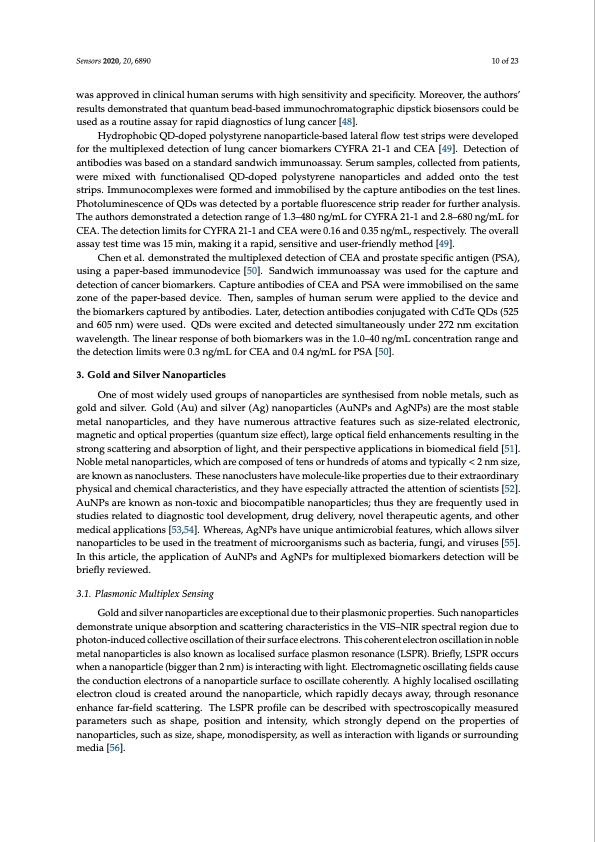
PDF Publication Title:
Text from PDF Page: 010
Sensors 2020, 20, 6890 10 of 23 was approved in clinical human serums with high sensitivity and specificity. Moreover, the authors’ results demonstrated that quantum bead-based immunochromatographic dipstick biosensors could be used as a routine assay for rapid diagnostics of lung cancer [48]. Hydrophobic QD-doped polystyrene nanoparticle-based lateral flow test strips were developed for the multiplexed detection of lung cancer biomarkers CYFRA 21-1 and CEA [49]. Detection of antibodies was based on a standard sandwich immunoassay. Serum samples, collected from patients, were mixed with functionalised QD-doped polystyrene nanoparticles and added onto the test strips. Immunocomplexes were formed and immobilised by the capture antibodies on the test lines. Photoluminescence of QDs was detected by a portable fluorescence strip reader for further analysis. The authors demonstrated a detection range of 1.3–480 ng/mL for CYFRA 21-1 and 2.8–680 ng/mL for CEA. The detection limits for CYFRA 21-1 and CEA were 0.16 and 0.35 ng/mL, respectively. The overall assay test time was 15 min, making it a rapid, sensitive and user-friendly method [49]. Chen et al. demonstrated the multiplexed detection of CEA and prostate specific antigen (PSA), using a paper-based immunodevice [50]. Sandwich immunoassay was used for the capture and detection of cancer biomarkers. Capture antibodies of CEA and PSA were immobilised on the same zone of the paper-based device. Then, samples of human serum were applied to the device and the biomarkers captured by antibodies. Later, detection antibodies conjugated with CdTe QDs (525 and 605 nm) were used. QDs were excited and detected simultaneously under 272 nm excitation wavelength. The linear response of both biomarkers was in the 1.0–40 ng/mL concentration range and the detection limits were 0.3 ng/mL for CEA and 0.4 ng/mL for PSA [50]. 3. Gold and Silver Nanoparticles One of most widely used groups of nanoparticles are synthesised from noble metals, such as gold and silver. Gold (Au) and silver (Ag) nanoparticles (AuNPs and AgNPs) are the most stable metal nanoparticles, and they have numerous attractive features such as size-related electronic, magnetic and optical properties (quantum size effect), large optical field enhancements resulting in the strong scattering and absorption of light, and their perspective applications in biomedical field [51]. Noble metal nanoparticles, which are composed of tens or hundreds of atoms and typically < 2 nm size, are known as nanoclusters. These nanoclusters have molecule-like properties due to their extraordinary physical and chemical characteristics, and they have especially attracted the attention of scientists [52]. AuNPs are known as non-toxic and biocompatible nanoparticles; thus they are frequently used in studies related to diagnostic tool development, drug delivery, novel therapeutic agents, and other medical applications [53,54]. Whereas, AgNPs have unique antimicrobial features, which allows silver nanoparticles to be used in the treatment of microorganisms such as bacteria, fungi, and viruses [55]. In this article, the application of AuNPs and AgNPs for multiplexed biomarkers detection will be briefly reviewed. 3.1. Plasmonic Multiplex Sensing Gold and silver nanoparticles are exceptional due to their plasmonic properties. Such nanoparticles demonstrate unique absorption and scattering characteristics in the VIS–NIR spectral region due to photon-induced collective oscillation of their surface electrons. This coherent electron oscillation in noble metal nanoparticles is also known as localised surface plasmon resonance (LSPR). Briefly, LSPR occurs when a nanoparticle (bigger than 2 nm) is interacting with light. Electromagnetic oscillating fields cause the conduction electrons of a nanoparticle surface to oscillate coherently. A highly localised oscillating electron cloud is created around the nanoparticle, which rapidly decays away, through resonance enhance far-field scattering. The LSPR profile can be described with spectroscopically measured parameters such as shape, position and intensity, which strongly depend on the properties of nanoparticles, such as size, shape, monodispersity, as well as interaction with ligands or surrounding media [56].PDF Image | Multiplexed Nanobiosensors: Current Trends in Early Diagnostics

PDF Search Title:
Multiplexed Nanobiosensors: Current Trends in Early DiagnosticsOriginal File Name Searched:
sensors-20-06890-v2.pdfDIY PDF Search: Google It | Yahoo | Bing
Turbine and System Plans CAD CAM: Special for this month, any plans are $10,000 for complete Cad/Cam blueprints. License is for one build. Try before you buy a production license. More Info
Waste Heat Power Technology: Organic Rankine Cycle uses waste heat to make electricity, shaft horsepower and cooling. More Info
All Turbine and System Products: Infinity Turbine ORD systems, turbine generator sets, build plans and more to use your waste heat from 30C to 100C. More Info
CO2 Phase Change Demonstrator: CO2 goes supercritical at 30 C. This is a experimental platform which you can use to demonstrate phase change with low heat. Includes integration area for small CO2 turbine, static generator, and more. This can also be used for a GTL Gas to Liquids experimental platform. More Info
Introducing the Infinity Turbine Products Infinity Turbine develops and builds systems for making power from waste heat. It also is working on innovative strategies for storing, making, and deploying energy. More Info
Need Strategy? Use our Consulting and analyst services Infinity Turbine LLC is pleased to announce its consulting and analyst services. We have worked in the renewable energy industry as a researcher, developing sales and markets, along with may inventions and innovations. More Info
Made in USA with Global Energy Millennial Web Engine These pages were made with the Global Energy Web PDF Engine using Filemaker (Claris) software.
Infinity Turbine Developing Spinning Disc Reactor SDR or Spinning Disc Reactors reduce processing time for liquid production of Silver Nanoparticles.
| CONTACT TEL: 608-238-6001 Email: greg@infinityturbine.com | RSS | AMP |